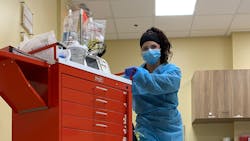Study shows seroprevalence of SARS-CoV-2 among frontline healthcare personnel in multistate hospital network
In a new release from the Centers of Disease Control and Prevention’s (CDC’s) Morbidity and Mortality Weekly Report, among 3,248 personnel observed, six percent of frontline healthcare personnel had antibody evidence of previous SARS-CoV-2 infection; 29 percent of personnel with SARS-CoV-2 antibodies were asymptomatic in the preceding months, and 69 percent had not previously received a diagnosis of SARS-CoV-2 infection.
Prevalence of SARS-CoV-2 antibodies was lower among personnel who reported always wearing a face covering while caring for patients (six percent), compared with those who did not (nine percent). A high proportion of SARS-CoV-2 infections among healthcare personnel appear to go undetected. Universal use of face coverings and lowering clinical thresholds for testing could be important strategies for reducing hospital transmission.
Healthcare personnel (HCP) caring for patients with COVID-19 might be at high risk for contracting SARS-CoV-2, the virus that causes COVID-19. Understanding the prevalence of and factors associated with SARS-CoV-2 infection among frontline HCP who care for COVID-19 patients are important for protecting both HCP and their patients. During April 3–June 19, 2020, serum specimens were collected from a convenience sample of frontline HCP who worked with COVID-19 patients at 13 geographically diverse academic medical centers in the United States, and specimens were tested for antibodies to SARS-CoV-2.
Participants were asked about potential symptoms of COVID-19 experienced since February 1, 2020, previous testing for acute SARS-CoV-2 infection, and their use of personal protective equipment (PPE) in the past week. Among 3,248 participants, 194 (6.0 percent) had positive test results for SARS-CoV-2 antibodies. Seroprevalence by hospital ranged from 0.8 percent to 31.2 percent (median = 3.6 percent). Among the 194 seropositive participants, 56 (29 percent) reported no symptoms since February 1, 2020, 86 (44 percent) did not believe that they previously had COVID-19, and 133 (69 percent) did not report a previous COVID-19 diagnosis. Seroprevalence was lower among personnel who reported always wearing a face covering (defined in this study as a surgical mask, N95 respirator, or powered air purifying respirator [PAPR]) while caring for patients (5.6 percent), compared with that among those who did not (9.0 percent).
Consistent with persons in the general population with SARS-CoV-2 infection, many frontline HCP with SARS-CoV-2 infection might be asymptomatic or minimally symptomatic during infection, and infection might be unrecognized. Enhanced screening, including frequent testing of frontline HCP, and universal use of face coverings in hospitals are two strategies that could reduce SARS-CoV-2 transmission.
HCP who care for patients with COVID-19 are at risk for exposure and infection during patient care–related activities, and once infected, can spread SARS-CoV-2 to patients, coworkers, and others in the community. Therefore, understanding the frequency of SARS-CoV-2 infection among frontline HCP and characteristics associated with infection among HCP is important for planning effective strategies for minimizing SARS-CoV-2 spread in healthcare settings and associated communities.
Most persons who are infected with SARS-CoV-2 develop antibodies to SARS-CoV-2 proteins within 1–2 weeks of infection. Serologic testing for SARS-CoV-2 antibodies, albeit having variable sensitivity and specificity, might provide a useful marker for identifying past SARS-CoV-2 infection. In this study, SARS-CoV-2 antibodies were measured among HCP who regularly cared for patients with COVID-19, with the aim of identifying past infection and describing characteristics associated with seropositive test results.
This study was conducted by the Influenza Vaccine Effectiveness in the Critically Ill (IVY) Network, which is a collaboration of academic medical centers in the United States conducting epidemiologic studies on influenza and COVID-19. Thirteen IVY Network medical centers from 12 states participated. Each hospital enrolled a convenience sample of HCP who regularly had direct patient contact in hospital-based units caring for adult COVID-19 patients since February 1, 2020, including emergency departments (EDs), intensive care units (ICUs), and hospital wards. Targeted enrollment was 250 participants per hospital, and volunteers were enrolled during April 3–June 19.
SARS-CoV-2 antibody detection differed among participants according to demographic characteristics. Seropositivity was lower among females (5.3 percent) than among males (7.2 percent) and among non-Hispanic White participants (4.4 percent) than among participants of other racial/ethnic groups (9.7 percent). Symptoms of an acute viral illness since February 1, 2020, were more prevalent in participants with antibodies detected (71 percent) than in those without antibodies detected (43 percent).
Notably, of 194 participants with antibodies detected, 86 (44percent) reported that they did not believe they previously had COVID-19, 56 (29 percent) reported no symptoms of an acute viral illness since February 1, 2020, and 133 (69 percent) had not previously had positive test results for acute SARS-CoV-2 infection. A previous positive test was reported by 61 participants, representing 31 percent of the 194 participants with antibodies detected and 66percent of 92 participants with both antibodies detected and previous SARS-CoV-2 testing completed.
Use of a face covering during all clinical encounters in the week preceding enrollment was reported by 2,904 (89 percent) participants. Detection of SARS-CoV-2 antibodies was less common among participants who reported using a face covering for all clinical encounters (six percent) than among those who did not (nine percent). Shortages of any PPE equipment since February 1, 2020, were reported by 398 (12 percent) participants; shortages of N95 respirators (reported by five percent of participants) were those most commonly reported. In eight of the 13 medical centers, >10 percent of participants reported a PPE shortage. A higher percentage of participants who reported a PPE shortage had detectable SARS-CoV-2 antibodies (nine percent) than did those who did not report a PPE shortage (six percent).
This study resulted in the identification of two factors potentially associated with SARS-CoV-2 infection among HCP: PPE shortages and interacting with patients without wearing a face covering. These findings highlight the importance of maintaining PPE supplies at hospitals caring for COVID-19 patients and, assuming adequate supply, adhering to policies that encourage the use of masks for all interactions between HCP and patients. Universal masking has been associated with a significantly lower rate of infection among HCP.
